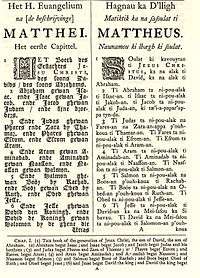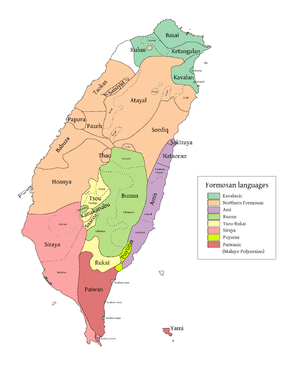Siraya language
| Siraya | |
|---|---|
| Native to | Taiwan |
| Region | Southwestern, around present-day Tainan, from Peimen to Hengchun to Tapu. |
| Coordinates | 22°58′N 120°18′E / 22.967°N 120.300°E |
| Extinct | end of 19th century; revitalization movement |
|
Austronesian
| |
| Language codes | |
| ISO 639-3 |
fos |
| Glottolog |
sira1267[1] |
|
(pink) Siraya | |
Siraya is a Formosan language spoken until the end of the 19th century by the indigenous Siraya people of Taiwan. Some scholars believe Taivoan and Makatao are two of Siraya dialects, but now more evidences show that they belong to different languages.
Several Siraya communities have been involved in a Sirayan cultural and language revitalization movement for more than a decade. Through linguistic research and language teaching, the natives are 'awaking' their mother tongue that has been 'dormant' for a century. Today a group of Siraya children in Xinhua District of Tainan particularly in Kou-pei and Chiou Chen Lin area are able to speak and sing in the Siraya language.[2]
Dialects
The Sirayaic languages include three languages or dialects:
- Siraya proper — spoken in the coastal area of Tainan Plain.
- Taivoan — spoken mostly in the inland of Tainan Plain to the north (just west of Southern Tsouic territories).
- Makatao — spoken in Kaohsiung and Pingtung Prefectures to the south (just west of Paiwan territories).
However, Li (2009) argues Taivoan and Makatao are two different languages, rather than two dialects of Siraya, based on the latest linguistic observations below:
| Siraya | Taivoan | Makatao | PA | |
|---|---|---|---|---|
| Sound change (1) | r | Ø~h | r | < *l |
| Sound change (2) | l | l | n | < *N |
| Sound change (3) | s | r, d | r, d | < *D, *d |
| Sound change (4) | -k-
-g- |
Ø
Ø |
-k-
---- |
< *k
< *S |
| Morphological change
(suffices for future tense) |
-ali | -ah | -ani |
Based on the discovery, Li attempted two classification trees:[3]
1. Tree based on the number of phonological innovations
- Sirayaic
- Taivoan
- Siraya–Makatao
- Siraya
- Makatao
2. Tree based on the relative chronology of sound changes
- Sirayaic
- Siraya
- Taivoan–Makatao
- Taivoan
- Makatau
Li (2009) considers the second tree (the one containing the Taivoan–Makatao group) to be the somewhat more likely one.
Sources

The Siraya language entered the historical record in the early 17th century when traders from the Dutch East India Company, expelled from mainland China and Chinese waters, set up a stronghold on Taiwan at Fort Zeelandia, which was in the Siraya-speaking area. During the period of Dutch rule in Taiwan, Calvinist missionaries used Siraya and Babuza (also known as Favorlang) as contact languages. A translation of the Gospel of St. Matthew into Siraya (174 pages of Siraya and Dutch text, Gravius 1661)[5][6] and a catechism in Siraya (288 pages of Siraya and Dutch text, Gravius 1662)[7] were published, and have been subsequently republished.[8] The Dutch colony was driven out in 1661 by Ming loyalist refugees from China, and Taiwan was subsequently incorporated into the Qing Empire. During the period of Qing Dynasty rule, use of Siraya receded, but some Siraya language materials survive in the form of Siraya land contracts with Chinese translations, known as the Sinckan Manuscripts. The last records were lists of words made in the early 19th century.
The Tainan Ping-pu Siraya Association is compiling the first modern-day Siraya glossary. Publication is scheduled for November 2008.
Phonology
The phonological system of Siraya is speculated by Adelaar (1997) to have the following phonemes.
Consonants (18-20 total)
b d nḡ[9]
p t k
m n ng
l, r
v z
c
[f] s x h
w y
Vowels (7 total)
- a, ä, i (ĭ), e, ə, u (ŭ), o
Diphthongs (6 total)
- ay, ey, uy, äw, aw, ow
Palatalization also occurs in many words.
Grammar
Siraya auxiliaries constitute an open class and are placed at the head of the verb phrase (Adelaar 1997).
Pronouns
The Siraya personal pronouns below are from Adelaar (1997).
| Type of Pronoun |
Free | Actor or Possessive |
Topic | Oblique |
|---|---|---|---|---|
| 1s. | ĭau | -(m)au | -koh | ĭau-an |
| 2s. | ĭmhu | -(m)uhu, -(m)oho | -kow | ĭmhu-an |
| 3s. | teni | tĭn | teni | tĭni-än (tĭni-an) |
| 1p. (incl.) | ĭmĭtta | -(m)ĭtta, -(m)eta | -kĭtta | ĭmittä-n |
| 1p. (excl.) | ĭmi-an | -(m)ian, -(m)iän | -kame | mian-än (mian-an) |
| 2p. | ĭmumi | -(m)umi | (-)kamu | ĭmumi-än (ĭmumi-an) |
| 3p. | ta neini | nein | neini | neini-än (neini-an) |
Function words
The list of function words below is sourced from Adelaar (1997).
Demonstratives
- atta, k(a)-atta 'this, these'
- anna, k(a)-anna 'that, those'
Interrogatives
- mang 'what?'
- ti mang 'who?'
- tu mang 'where'
- mama mang, mama ki mang, mameymang 'how?'
- kaumang 'why?'
Negation markers
- assi (also "aoussi") 'no(t)'
- ĭnna' don't'
- nĭnno 'nothing'
- mi-kakua.. . assi ("myhkaqua ... assi") 'never'
- ĭnnang ("ynnang") 'refuse to, not want to; don't'
Other words
- ti - personal article
- ta - topic marker
- tu - locative marker
- ki - default relation marker
- tu ämäx ki - "before"
- tu lam ki - "together with"
- ka - coordinating conjunction (links verbal clauses)
Verbs
The following list of Siraya verb affixes is from Adelaar (1997).
- Affixes
- ni-: past tense
- ma-, m-, -m-: actor focus / orientation
- pa-: undergoer focus / orientation
- mey- ~ pey-: actor- and undergoer-oriented verbs (used with verbs describing a high degree of physical involvement)
- mu- ~ (p)u-: actor- and undergoer-oriented verbs (used with verbs describing a movement toward something)
- ma-: stative intransitive verbs; words with no apparent word-class affiliations (precategorials)
- paka-: causative
- pa-: transitive (often with causative result)
- ka-: expresses feeling, emotion, sensation (undergoer-oriented verbs and deverbal nouns only)
- -ən, -an: undergoer focus / orientation
- -a, -ey, -aw: irrealis
- -(l)ato: possibly a perfective marker
See also Proto-Austronesian language for a list of Proto-Austronesian verbal affixes.
- Classifiers
Like Bunun and many other Formosan languages, Siraya has a rich set of verbal classifier prefixes.
- mattäy- / pattäy-: "talking, saying"
- smaki-: "throwing,casting"
- sau-: "swearing, making an oath"
- mu-, pu-: movement into a certain direction
- mey- / pey-: high degree of physical involvement
- sa-: movement through a narrow place
- taw-: downward movement, a movement within a confined space
Numerals
Siraya has a base ten numeral system with the following forms:[8]
| Cardinal | Ordinal | |
|---|---|---|
| 1 | saat, sa-saat | nawnamu |
| 2 | ruha, ru-ruha | ka-ra-ruha |
| 3 | turu, tu-turu | ka-ta-turu |
| 4 | xpat, pa-xpat | ka-axpat |
| 5 | rima, ri-rima | ka-ri-rima |
| 6 | nom, nə-nəm | ka-annəm |
| 7 | pĭttu, pĭ-pĭttu | ka-pa-pĭttu |
| 8 | kuixpa | ka-kuixpa |
| 9 | matuda | ka-matuda, ka-ma-matuda |
| 10 | saat kĭttiän | ka-sasaat kĭttiän |
| Examples of higher numerals | ||
| 12 | saat kĭttiän äb ki ruha | |
| 14 | saat kĭttiän äb ki pat | |
| 30 | turu kĭttiän | |
| 60 | nənnəm kĭttiän | |
| 99 | matuda kĭttiän äb ki matuda | |
| 100 | saat ka-ätux-an | |
| 4,000 | xpat ka-tunnun-an | |
| 5,000 | lima ka-tunnun-an |
Examples
- The Lord's Prayer
Raman-jan ka ito-tounnoun kow ki vullu-vullum;
Pakou-titik-auh ta nanang-oho,
Pa-irou-au ta pei-sasou-an- oho,
Paamt-au ta kamoei-en-hou, mama tou tounnoun ki vullum, k'ma-hynna tou Naei
Ph'ei -kame wae'i k'atta ki paoul-ian ka mamsing.
Atta-ral-a ki kaeu-itting-en-hou ymiaen-an, mama ka attaral-kame ta ymiaen ki kaeu-itting-'niaen
Ka inei-kame dmyllough tou repung-an, ra haoumi-ei-kame ki littou.
Ka a'mouhou ta pei-sasou-an, ta pei-lpoug-han, ta keirang-en ki kidi tou yhkaquan myd-darynnough,
Amen
See also
- Daniel Gravius - Siraya language scholar
- Sinckan Manuscripts
References
- ↑ Hammarström, Harald; Forkel, Robert; Haspelmath, Martin; Bank, Sebastian, eds. (2016). "Siraya". Glottolog 2.7. Jena: Max Planck Institute for the Science of Human History.
- ↑ Musu hapa Siraya (in Chinese)
- ↑ Li, Paul Jen-kuei (2009). "Linguistic differences among Siraya, Taivuan, and Makatau". In Adelaar, A; Pawley, A. Austronesian historical linguistics and culture history : a festschrift for Robert Blust. Canberra: Pacific Linguistics, Research School of Pacific and Asian Studies, Australian National University. ISBN 9780858836013.
- ↑ Campbell & Gravius (1888), p. 1.
- ↑ Gravius, Daniel (1661). Het heylige Euangelium Matthei en Johannis. Ofte Hagnau ka d'llig matiktik ka na sasoulat ti Mattheus ti Johannes appa. Amsterdam: Michiel Hartogh. OCLC 69326189.
- ↑ Campbell, William; Gravius, Daniel (1888). The Gospel of St. Matthew in Formosan (Sinkang dialect) with corresponding versions in Dutch and English (in Austronesian, Dutch, and English). London: Trubner. OCLC 844610148.
- ↑ Gravius, Daniel (1661). Patar ki tna-'msing-an ki Christang ofte. 't Formulier des Christendoms. Amsterdam: Michiel Hartogh. OCLC 846467128.
- 1 2 Adelaar, K.A. (1997). "Grammar notes on Siraya, an extinct Formosan language". Oceanic Linguistics. University of Hawai'i Press. 36 (2): 362–397. JSTOR 3622990. doi:10.2307/3622990.
- ↑ The exact phonemic value of "nḡ," as it appears in Siraya language documents, is unknown.


